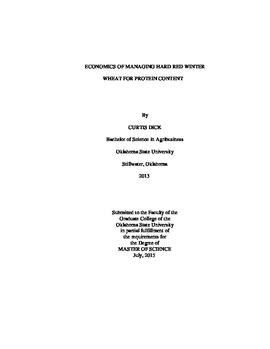| dc.contributor.advisor | Epplin, Francis M. | |
| dc.contributor.author | Dick, Curtis | |
| dc.date.accessioned | 2016-09-29T18:39:39Z | |
| dc.date.available | 2016-09-29T18:39:39Z | |
| dc.date.issued | 2015-07-01 | |
| dc.identifier.uri | https://hdl.handle.net/11244/45248 | |
| dc.description.abstract | Hard Red Winter Wheat (HRW) is the primary cash crop grown in Oklahoma. HRW wheat is graded on physical characteristics such as moisture content, percent defects, test weight, and protein content. The average Oklahoma producer�s wheat will be tested for all of these characteristics except protein content. The overall objective of this research is to determine the expected net returns from the production of Oklahoma HRW wheat managed for enhanced grain protein content and marketed to enhance the probability of receiving a protein premium price. Data were collected in an Oklahoma field experiment at Lahoma and Lake Carl Blackwell in 2011, 2012 and 2013. Treatments included four rates of late season foliar N applied in the form of two different sources of N at two different growth stages. A linear response plateau functional form was found to provide the best fit to the data. The plateau N rate was 9.5 pounds per acre applied at the growth stage of post anthesis (Feekes 10.5). The average plateau protein percentage was 14.41. The costs of field operations and the prices of inputs were calculated to determine if a late season foliar N application at flag leaf (Feekes 9) or post anthesis (Feekes 10.5) to facilitate production of high protein wheat was economical. The protein premiums required for a slightly risk averse producer to be indifferent between producing high protein wheat and utilizing traditional methods ranged from $0.44 to $0.50 per bushel, for the four different production systems analyzed in the study. The average protein premium for wheat with 12.6% protein was $0.40 per bushel. The greatest barrier to producers capturing these premiums is the capability to deliver the wheat at a time and location that would pay a protein premium. Protein value depends on the quantity available in marketing channels. This is not known until the United States wheat crop is harvested, tested, and stored. In some years there is a possibility that regionally there will not be a premium for high protein wheat. | |
| dc.format | application/pdf | |
| dc.language | en_US | |
| dc.rights | Copyright is held by the author who has granted the Oklahoma State University Library the non-exclusive right to share this material in its institutional repository. Contact Digital Library Services at lib-dls@okstate.edu or 405-744-9161 for the permission policy on the use, reproduction or distribution of this material. | |
| dc.title | Economics of Managing Hard Red Winter Wheat for Protein Content | |
| dc.type | text | |
| dc.contributor.committeeMember | Brorsen, B. Wade | |
| dc.contributor.committeeMember | Arnall, Brian | |
| osu.filename | Dick_okstate_0664M_14160.pdf | |
| osu.accesstype | Open Access | |
| dc.description.department | Agricultural Economics | |
| dc.type.genre | Thesis | |
